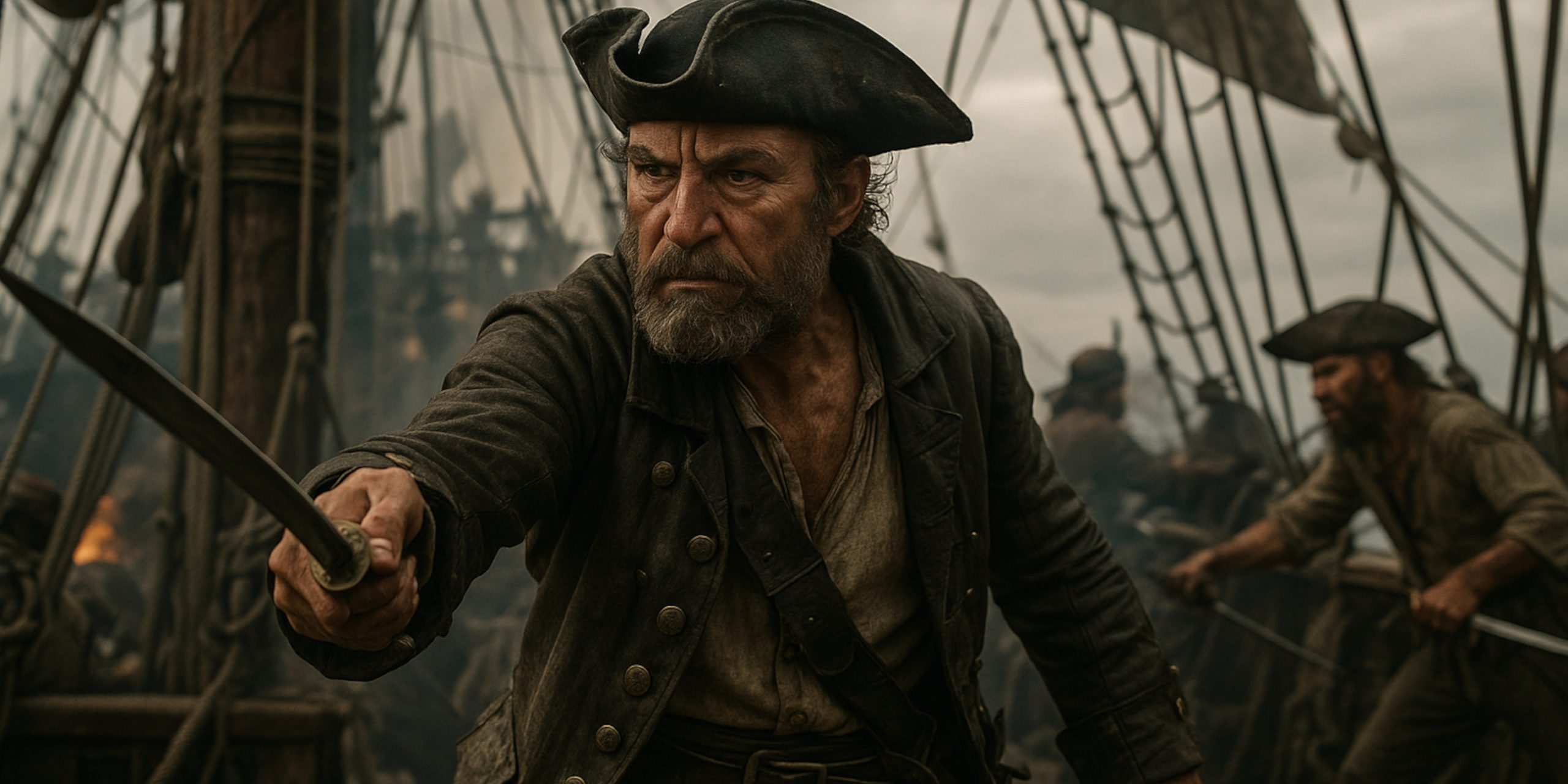
Piracy has long captured the imagination, but behind the romanticised image lies a record of bloodshed, opportunism, and desperate violence. Pirate battles were rarely grand in scale, yet their impact on trade routes, colonial powers, and maritime law was substantial. The following engagements stand out not just for their brutality, but for the legacies they left behind.
Battle of Cape Lopez (1722)
Location: Off the coast of modern-day Gabon
This battle marked the end of Bartholomew Roberts, one of the most successful pirates of the Golden Age. After a prolific career plundering over 400 ships, Roberts met his fate when the British warship HMS Swallow, under Captain Chaloner Ogle, ambushed him near Cape Lopez. A single broadside killed Roberts instantly, ending the dominance of one of piracy’s most formidable figures. The engagement led to a crackdown on piracy by the Royal Navy across the Atlantic.
Capture of the Royal Fortune (1721)
Location: Guinea Coast
Before the events at Cape Lopez, Roberts had already drawn the attention of several navies. The Royal Fortune, his flagship, was pursued relentlessly by British forces. While the final showdown would come in 1722, the running skirmishes of 1721 saw multiple confrontations with European ships. Roberts’ ability to escape repeatedly, using cunning seamanship and false colours, highlighted both the boldness and limits of pirate resistance against state power.
Battle of Santiago de Cuba (1554)
Location: Santiago de Cuba, Spanish Caribbean
François Le Clerc, a French privateer nicknamed “Jambe de Bois”, launched a savage attack on the Spanish port of Santiago de Cuba. With support from English pirates, he stormed the defences, looted the city, and occupied it for nearly a month. Le Clerc’s use of combined arms with land-based raiding and naval firepower was a precursor to more organised buccaneering tactics in the Caribbean. Spain responded with tighter colonial defences, marking a shift in how piracy would be countered in the region.
Battle of the Sulu Sea (1599)
Location: Sulu Sea, near the southern Philippines
In Southeast Asia, piracy was deeply embedded in regional conflict. The Sultanate of Brunei’s fleet, in alliance with Mindanao raiders, confronted Spanish colonial ships near the Sulu Sea. It was a fierce encounter involving war junks and galleons. The Spanish suffered significant losses, and the defeat curbed their ambitions in the area for years. This battle represents the broader struggles between European colonial powers and indigenous naval raiders.
Battle of Ocracoke Inlet (1718)
Location: North Carolina, American Colonies
Blackbeard, or Edward Teach, was a fearsome pirate whose reign came to an end at Ocracoke Inlet. Lieutenant Robert Maynard of the Royal Navy lured Blackbeard into a trap, disguising his sloops as merchant vessels. The ensuing close-quarters fight was brutal. Blackbeard suffered numerous wounds before finally being decapitated. His death was publicised widely in Britain and the colonies, becoming a turning point in the campaign to restore order to Atlantic shipping lanes.
The Capture of Nassau (1718)
Location: New Providence, Bahamas
While not a battle in the traditional sense, the British seizure of Nassau ended the pirate republic that had thrived in the Bahamas. Governor Woodes Rogers, backed by the Royal Navy and armed with pardons for pirates who surrendered, faced little resistance. Yet some, like Charles Vane, refused to yield and continued their attacks elsewhere. The fall of Nassau shifted the balance and marked the beginning of the end for large-scale piracy in the Caribbean.
Battle off Cartagena (1697)
Location: Cartagena, Spanish Main
French buccaneers allied with regular navy forces in a bold raid against the heavily fortified city of Cartagena. Although more a privateering expedition than outright piracy, it blurred the line between state-sanctioned war and plunder. After intense sea fighting and a siege, the city was ransacked. The raid illustrated how piracy and privateering were often extensions of geopolitical rivalry, particularly during the Nine Years’ War.
Battle of Matapan (1695)
Location: Cape Matapan, southern Greece
This lesser-known engagement saw a mixed group of English and Dutch pirates intercept and attack an Ottoman convoy. The corsairs, operating from bases in the Aegean and often collaborating with local forces, managed to seize valuable cargo before retreating into the maze of Greek islands. The Ottoman Empire responded with a more aggressive anti-pirate naval policy in the eastern Mediterranean, demonstrating how piracy could provoke wider military consequences.
Legacy and Significance
Pirate battles rarely matched formal naval engagements in scale, but they were often far more unpredictable and vicious. Whether fought for personal gain, rebellion, or as part of colonial conflict, these clashes shaped the maritime policies of empires. They led to fortified coasts, new naval patrols, and a growing divide between the romantic image of the pirate and the brutal realities they imposed on seafaring life.
What defines these battles as infamous is not just the blood spilled or ships lost, but the long shadows they cast across oceans, trade networks, and the legal systems built to suppress them.



